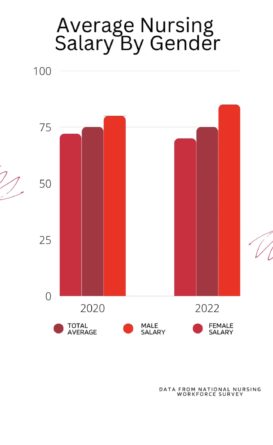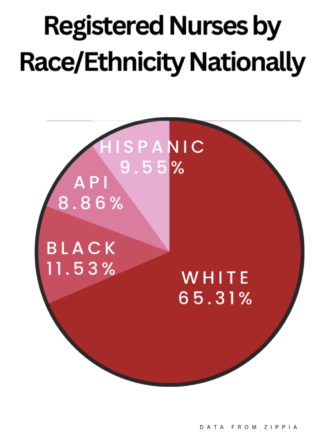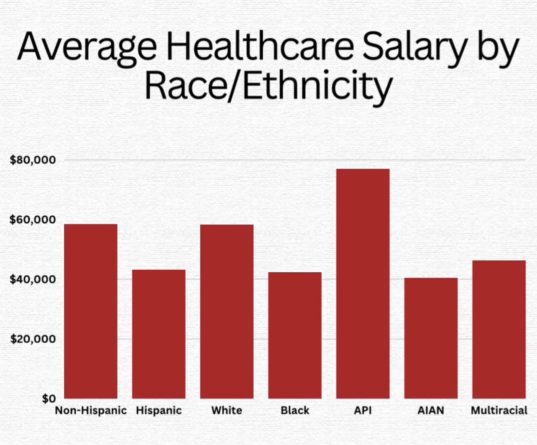By: Autumn Klein
FAYETTEVILLE, Ark. (UATV) – Statistics show that there has been a wage gap in nurses pay for a long time, but recent data shows these numbers are increasing even more.
With nearly 4.2 million registered nurses reported in 2022, the nursing industry is the nation’s largest healthcare profession, according to the Journal of Nursing Regulation. The U.S. Bureau of Labor Statistics projects the employment of registered nurses to grow 6% from 2021 to 2031. Not only do registered nurses make up one of the largest segments of the U.S. workforce as a whole, but they also make up one of the highest paying occupations according to the Bureau. Data from the Bureau of Labor Statistics shows the average registered nurse makes $77,600 a year, compared to the national occupational salary average of $45,760, but some nurses appear to be making more than others.
Gender Gaps
Of all nurses in the United States, over 85% are women; however, the small percentage of male registered nurses have a significantly higher salary. Data from 2020 showed the average male RN making $7,300 more than the average female nurse, but in the past year this number has almost doubled. According to a salary research report from Nurse.com, male RNs now make an average of $14,000 more per year than female RNs. Data from the National Nursing Workforce Survey shows that for hourly wages, women RNs are paid 91 cents to every dollar earned by men. 
For registered nurse, Katelyn Alexander, the higher pay is not the only privilege she has seen male nurses receive.
“Men do seem to climb the ladder a lot more quickly than women in the nursing field, and it also seems like they are a lot more respected by the physicians – and even patients, sometimes. A lot of times a male nurse will walk into the room and the patient thinks that they’re the doctor, and so they automatically get that respect too. It’s assumed that since they’re a male, they must be the doctor,” Alexander said.
Alexander said the stereotype goes both ways. She said she has a friend who is an ER physician that often gets mistaken as a nurse when she enters a patients room. She said it seems that many people are just programmed to think this way.
This gender wage gap is not exclusive to the field of nursing. According to the U.S. Department of Labor, women earn less than men in almost every occupation. In just 2021, the Census Bureau found that overall on average, women made 82 cents for every dollar men made. In this same dataset, it was found that women made up approximately 44% of the overall workforce, but only 41% of managers. Not only that, but the pay gap for female and male managers is even more significant. In 2021, full-time female managers earned an estimated 77 cents for every dollar made by a full-time male manager. With that being said, the gender wage gap in the field of nursing is so significant because of the fact that the field is female-dominated, and because RNs make up one of the most employed and best-paid segments in the U.S. workforce.
Mallory Turner is a current nursing student, expected to be a RN by the Spring. For future nurses like Turner, there are concerns about how this could affect her future of applying for jobs.
“It concerns me to where I feel like if a male and I were applying for the same job, would that male get hired over me?” Turner said.
Race/Ethnicity Gaps
Gender is not the only significant wage gap in the field. Data from the Medical Care Journal shows a significant wage gap among different races and ethnicities as well.
 For starters, the RNs in the United States are predominantly white. Statistics from 2021 showed 65.31% of nurses to be White, 11.53% Black or African American, 8.86% Asian and 9.55% Hispanic or Latino.
For starters, the RNs in the United States are predominantly white. Statistics from 2021 showed 65.31% of nurses to be White, 11.53% Black or African American, 8.86% Asian and 9.55% Hispanic or Latino.
In a research study of over 140,000,000 healthcare workers over the course of eight years, it was shown that Asian/Pacific Islanders, Non-Hispanic and White healthcare workers had much higher salaries, on average, than Black, American Indian/Alaska Native, Multiracial and Hispanic healthcare workers. The highest average salary coming from API workers sat at $76,959, compared to the lowest, AIAN, at an average of $40,399.

Mallory Turner said she doesn’t believe that there is anything she can do that someone of a different race, ethnicity or gender couldn’t and vice versa.
“I don’t think it’s fair because we are all doing the same thing… it should be equal,” Turner said.
Why is it this way?
So, why is there such a significant wage gap in the nursing field? While there doesn’t seem to be an exact answer, there are some ideas out there.
According to the 2022 Nurse Salary Research Report, men were 40% more likely to negotiate their salary, which could be a factor in the gender wage gap. A Medscape RN/LPN Compensation Report found that male nurses were also more likely to work overtime hours than female nurses. The report also found male nurses more likely to work at inpatient hospitals (higher paying than outpatient), more likely to work in urban areas, which usually pay more than rural areas, and more likely to take more on-call and high-differential shifts – all potential factors in the gender wage gap.
Katelyn Alexander has said she notices some of these things herself. She said, “there are different roles within nursing that are higher paying positions that seem to attract males, so I don’t know if that has anything to do with it.” Which according to the data, it does.
Bryan Onyekwelu is a Black nursing student expecting to become a registered nurse this year. He has four years of experience working in a hospital as a patient care technician. He said that maybe men make more money because of the fact that there are less of them.
“As a male in this industry, there are some times where it is valuable to be a male nurse. There are a shortage of male nurses in the nation and just in general, it isn’t the most masculine profession… [but] I’m not sure why there would be such a gap,” Onyekwelu said.
For Onyekwelu, even though there is a shortage of male nurses, there is no reason as to why there is a such a significant wage gap in regards to gender, or race.
“As someone who does work in the field, I know the field wouldn’t be half of what is is without the women that work in it. I just feel like everyone should be paid equally,” Onyekwelu said.
As for the race and ethnicity wage gaps, there are also potential explanations. The Medical Care Journal said “studies have shown that patients prefer providers who share similar sex, racial, ethnic, and/or language characteristics,” which could be a factor. Research from the National Library of Medicine, also presented some potential explanations for the race and ethnicity wage gaps. One explanation being “human capital” – a concept introduced in the early 1960s by economist Theodor Schultz, who describes it as “those characteristics of individuals that are valued in the labor market, such as educational attainment, experience, skills, and competencies.” Another potential explanation is discrimination. The journal article discusses two nursing studies that examined racial/ethnic bias in RN promotions and found some supporting evidence of discrimination in the field. Again, no specific explanation alone has been confirmed.
What can be done
A 2020 report from the American Association of University Women states that at the current rate, the pay gap will continue to exist until the year 2111, unless something is changed. Nurse.com and Incredible Health list some ways to end this wage gap sooner. Some tips from these sites include:
- Don’t be afraid to try and negotiate for higher pay
- Discuss the pay gap with your leadership
- Choose an organization that values equity and transparency
- Try to take on per diem shifts
- Pursue advanced education or certification
- Explore different areas of practice
- Explore different locations


